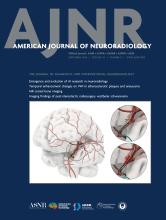This article requires a subscription to view the full text. If you have a subscription you may use the login form below to view the article. Access to this article can also be purchased.
Abstract
BACKGROUND AND PURPOSE: In fetuses with lateral ventriculomegaly and normal posterior fossa cerebrospinal spaces, third ventricle distention is a compelling clue that supports a diagnosis of aqueductal stenosis. However, this association assumes normal ventricular anatomy. Structural constraints can impair pressure-induced compliance. We aimed to determine how thalamic massa intermedia size alterations may impact the size of the third ventricle in the setting of congenital aqueductal stenosis.
MATERIALS AND METHODS: This retrospective study was performed at a single academic pediatric hospital after institutional review board approval. We searched our brain MRI reports for all examinations describing aqueductal stenosis and included all the patients who had both fetal and postnatal examinations. Patients with interhypothalamic adhesions and hydrocephalus unrelated to congenital aqueductal stenosis were excluded from this study. We evaluated all the MRIs for the presence of thalamic massa intermedia and documented third ventricle diameters (supraoptic recess, central and suprapineal recesses) and the thalamic massa intermedia circumference. The Spearman correlation was used to identify the potential relationship between the thalamic massa intermedia circumference and third ventricle size in fetal and postnatal MRIs. Patients were also stratified into 2 groups based on the presence or absence of thalamic massa intermedia. Mann-Whitney U tests were used to compare third ventricle diameters between these groups.
RESULTS: The study included both fetal and postnatal studies from 59 patients. The overall third ventricle diameter was inversely proportional to the circumference of the thalamic massa intermedia in both groups (fetal: P = .001, ρ = −0.422; [95% CI, −0.628 to −0.181]; postnatal: P < .001, ρ = −0.653; [95% CI, −0.782 to −0.479]). Nonetheless, dilation of anterior and posterior recesses still occurred when the mid third ventricle was nondilated or less severely dilated in patients with an enlarged thalamic massa intermedia. Third ventricle dilation was most severe in patients lacking a thalamic massa intermedia compared with patients with a thalamic massa intermedia (P < .001).
CONCLUSIONS: In patients with suspected congenital aqueductal stenosis, lack of marked third ventriculomegaly as conventionally measured can sometimes be explained by thickening of the thalamic massa intermedia. In this circumstance, it is important to evaluate the extreme recesses of the third ventricle for evidence of dilation on fetal MRI.
ABBREVIATIONS:
- CAS
- congenital aqueductal stenosis
- IQR
- interquartile range
- TMI
- thalamic massa intermedia
- © 2024 by American Journal of Neuroradiology












